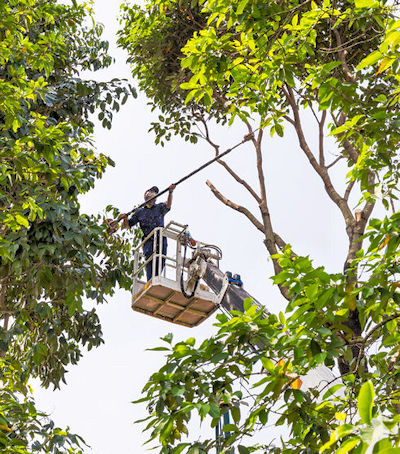31.E Other Operations and Equipment.
31.E.01 Pruning and trimming.
- Pole pruners, pole saws, and similar tools must be equipped with wood or nonmetallic poles. Actuating cords must be of a non-conducting material.
- Pole pruners and pole saws must be hung securely in a vertical position with the sharp edges away from employees. They must not be hung on utility wires or cables or left overnight in trees.
- When necessary, warning must be given by the worker in the tree before a limb is dropped.
- A scabbard or sheath must be hooked to the climbing belt to carry a handsaw when not in use.
- A separate lowering/rigging line must be attached to limbs that cannot be dropped safely or are too heavy to be controlled by hand. The lowering/rigging line should be held by workers on the ground end of the rope. Use of the same crotch for both the climbing line and the lowering/rigging line must be avoided.
- Cut branches must not be left in trees overnight.
- A service line must be installed for operations lasting overnight or longer and must be used to bring the climbing line back into position at the start of the next day's work.
31.E.02 Limbing and bucking.
- Chainsaw cut-resistant leg protection must be worn by the chainsaw operator for all chainsaw operations on the ground.
- When more than one worker is limbing or bucking a tree, each must be positioned and their duties organized so that the actions of one worker will not create a hazard for any other worker.
- Branches bent under tension must be considered hazardous.
- Chainsaws should be operated away from the vicinity of the legs and feet. Natural barriers, such as limbs between the saw and the body, should be employed where possible, while ensuring proper balance. While operating a chainsaw, the preferred working position is on the uphill side of the work.
- The tree worker must block the log to prevent rolling when necessary. Before bucking or limbing wind-thrown trees, precautions must be taken to prevent the root ball or butt log from striking a worker.
- When bucking, wedges must be used as necessary to prevent binding of the guide bar or chain.
- The worker must make sure of firm footing before and during limbing and bucking. The worker must not stand on loose chunks or logs that will roll when the cut is complete.
Knowledge Check Choose the best answer for the question.
31-9. Which of the following is required for all chainsaw operations on the ground?
You forgot to answer the question!

